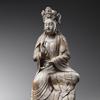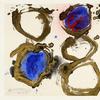Tiffany Favrile Glass: Masterworks from the Collection of Stanley and Dolores Sirott at The Huntington
- SAN MARINO, California
- /
- July 18, 2017
Prime examples of Tiffany glass from one of the most significant private collections in the U.S. to go on view this fall
Thirty-two exquisite glass vases designed by Louis Comfort Tiffany, on loan from a private collection, will feature in an exhibition opening this fall at The Huntington Library, Art Collections, and Botanical Gardens. “Tiffany Favrile Glass: Masterworks from the Collection of Stanley and Dolores Sirott” will survey the full range of Tiffany’s Favrile glass vase production, from experimental pieces made in the 1890s to the widely-admired peacock vases produced in the early years of the 20th century. The exhibition opens Oct. 7, 2017, and continues through Feb. 26, 2018, in the Virginia Steele Scott Galleries of American Art.
The Sirott Collection is one of the most significant private collections of Tiffany Favrile glass in the United States, comprising almost 300 objects—a small but select sampling of which will be included in the exhibition.
While Tiffany is famous for many types of glass work, including stained glass windows, the Sirott Collection focuses exclusively on Tiffany’s Favrile vases. These lustrous vessels, known for their innovative forms and colors, are among the most exquisite examples of Art Nouveau-inspired decorative art created in this country.
Louis Comfort Tiffany (1848–1933) was among the leading figures in the late 19th-century American Arts and Crafts Movement. The scion of the great jewelry empire founded by his father, Charles Lewis Tiffany, he declined to enter the family business, opting instead to pursue a career as a painter and designer. Following early success in designing leaded glass windows, Tiffany built a glasshouse in Corona, Queens, New York. His studios ultimately became the best-known and most commercially successful glass producer in the United States.
Tiffany’s skill as an entrepreneur drove the firm’s success. But he also convened an immensely talented team of craftsmen and designers. Chief among them was the English glassmaker Arthur Nash, who ran the Tiffany foundry, and the experimental chemist Parker C. McIlhiney, who discovered the process for creating brilliant iridescent glass that distinguished Tiffany’s work from his contemporaries.
Tiffany coined the name “Favrile,” taking it from the Old English word fabrile, or hand-wrought. Tiffany’s glassmakers used a patented process that treated molten glass with metallic oxides, creating luminous hues within the glass. This ability to manipulate color in the structure of the glass itself, as opposed to applying it as surface decoration, was Tiffany’s greatest contribution to the art of glassmaking.
The exhibition will shed light on Tiffany’s sources of inspiration, from the natural world to ancient glass and beyond. It will also give viewers the opportunity to study examples of each important category of Tiffany vase production: Flowerform vases, inspired by the graceful and sinuous forms of the natural world; Byzantine vases, with intersecting zigzags of color suggestive of ancient design motifs (reflecting Tiffany’s own interest in collecting ancient glass); Cypriote vases, with rusticated, pocked surfaces streaked with iridescent hues, playing with the idea of antiquity and archaeology; Aquamarine vases, the rarest of Tiffany vessels, inspired by the underwater world of the Caribbean as seen through a glass-bottomed boat; Peacock vases, epitomizing the refinement and symbolism of the Art Nouveau movement; Agate vases, with surfaces designed to recreate polished beach pebbles; Lava vases, highly prized for the difficulty of the technique that ornaments each piece with flows of molten glass, bringing to mind nature’s geological forces; Cameo vases, etched with delicate relief carvings on the surface of the glass; and Miniatures, jewel-like small vessels in a variety of innovative designs.
“We're delighted to share these gems from the Sirotts’ important collection of Tiffany glass. This exhibition provides the unique opportunity to examine glass masterworks that are rarely seen by the public," said Chad Alligood, The Huntington’s Virginia Steele Scott Chief Curator of American Art. "With our first-rate collection of American decorative arts and our emphasis on art in the context of nature, The Huntington provides the ideal context for this exhibition.” The Huntington is fortunate to have several examples of Favrile glass in its permanent collection, including one of Tiffany’s earliest pieces and a monumental vase that was once owned by Louis Comfort Tiffany himself.
Support for this exhibition is provided by Jonathan and Karin Fielding, Susan W. and Carl W. Robertson, and funds from Steve Martin for exhibitions of American art. Additional funding is provided by Christine and Ken Bender and Tiffany & Co.






100x100_c.jpg)













![Peter Paul Rubens (Flemish, 1577–1640), After Titian (Tiziano Vecelli) (Italian [Venetian], c. 1488–1576), Rape of Europa, 1628–29. Oil on canvas, 71 7/8 x 79 3/8 in. Peter Paul Rubens (Flemish, 1577–1640), After Titian (Tiziano Vecelli) (Italian [Venetian], c. 1488–1576), Rape of Europa, 1628–29. Oil on canvas, 71 7/8 x 79 3/8 in.](/images/c/e2/2e/Jan20_Rape_of_Europa100x100_c.jpg)
